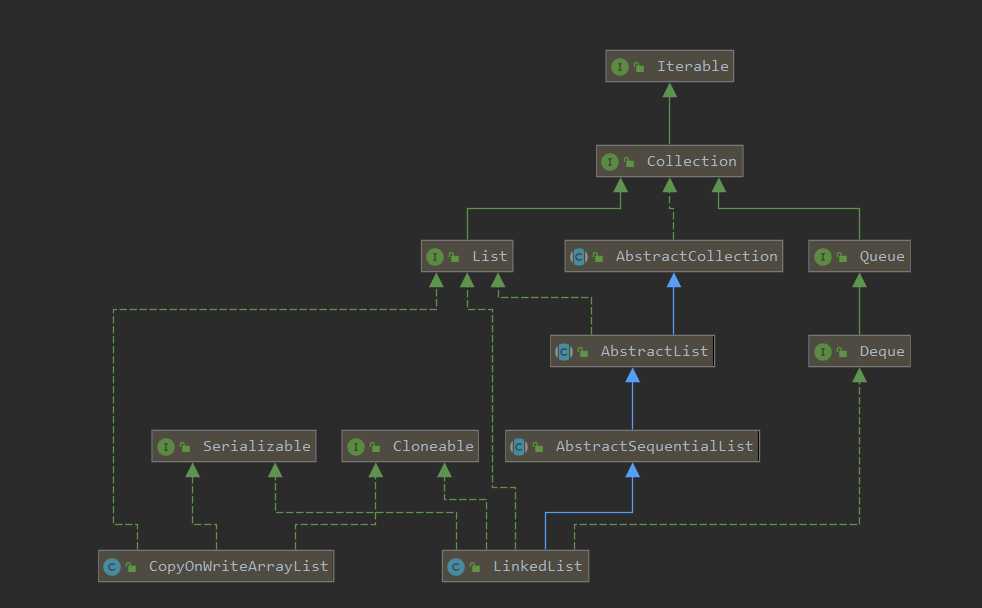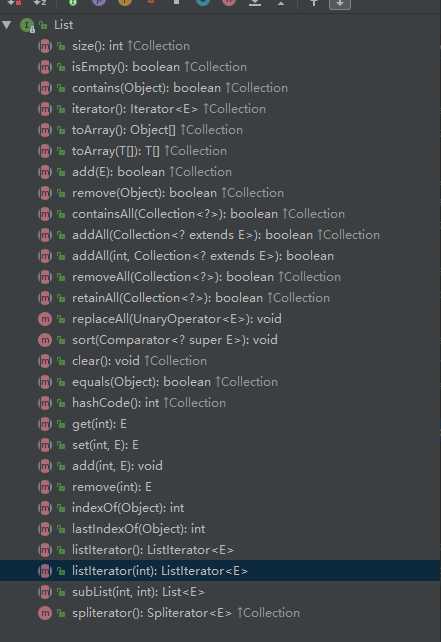一、List的解析
List是 java 中的有序列表,按照元素加入的顺序有序存储,元素可以重复,它的实现类主要包括 ArrayList、Vector 、LinkedList 等。
List 相关类图如下所示:

List提供的方法声明如下图所示:

List 继承自Collection 类,拥有Collection 所有的方法,如 add(E e)、size()、isEmpty()、remove(Object o)、clear()、itrator() 等,同时也有 Collection 没有的方法声明,如 List 提供了可以按照元素的索引位置增删改的方法 add(int index)、remove(int index)、set(int index,E e), List 接口除了正常的itrator()迭代器的功能,还提供了一种特殊的迭代器 ListIterator,该迭代器继承自 Iterator,故提供了Iterator 的一切功能,允许元素的插入和更换,同时允许获取从指定位置开始的迭代器。
ListIterator<E> listIterator(); ListIterator<E> listIterator(int index); // 指定位置开始
二、ArrayList的解析
ArrayList 是 List 的实现子类之一,是最常用的List,它的底层是使用数组实现的,因此需要一段连续的内存空间,数组的大小可以调整。
public class ArrayList<E> extends AbstractList<E> implements List<E>, RandomAccess, Cloneable, java.io.Serializable {}
ArrayList 继承自抽象类 AbstractList ,实现了 List、RandomAccess、Cloneable、Serializable,表明它支持随机访问、克隆及序列化操作,之所以继承AbstractList是因为它当中有部分已有方法体的函数可以供子类直接使用,如果需要的话,子类还可以重写。
1、成员变量常量
private static final int DEFAULT_CAPACITY = 10; // 默认的数组容量,即构造方法无参数时的数组容量 private static final Object[] EMPTY_ELEMENTDATA = {}; private static final Object[] DEFAULTCAPACITY_EMPTY_ELEMENTDATA = {}; transient Object[] elementData; // 没有使用private修饰方便嵌套类的访问 private int size; // elementData 数组中已存储的元素数量,<=elementData.length protected transient int modCount = 0; // 用于记录发生结构性修改的次数,如add、remove方法,codCount会加1
2、构造函数
ArrayList有三个构造函数:
public ArrayList(int initialCapacity) { // 初始化数组容量 if (initialCapacity > 0) { this.elementData = new Object[initialCapacity]; } else if (initialCapacity == 0) { this.elementData = EMPTY_ELEMENTDATA; } else { throw new IllegalArgumentException("Illegal Capacity: "+ initialCapacity); } } public ArrayList() { this.elementData = DEFAULTCAPACITY_EMPTY_ELEMENTDATA; // {} 空数组 } public ArrayList(Collection<? extends E> c) { elementData = c.toArray(); if ((size = elementData.length) != 0) { // c.toArray might (incorrectly) not return Object[] (see 6260652) if (elementData.getClass() != Object[].class) // 存在不为Object[].class的情况,复制的Object数组赋值给elementData elementData = Arrays.copyOf(elementData, size, Object[].class); } else { // replace with empty array. this.elementData = EMPTY_ELEMENTDATA; } }
Collection 中 toArray 的声明方式为 “Object[] toArray()”,但在参数如果传入 Arrays.asList("a","b","c") 的话,elementData.getClass() 将是String[].class,因为Arrays.asList内部toArray是将内部存储的数组指向传入的数组,存储类型是取决于传入类型,而不一定是Object[];而如ArrayList存储的Object类型的数组,toArray是以 Arrays.copyOf(elementData, size) 的方式实现的,返回类型当然是Object[]。
2、add方法
ArrayList 中提供了两个 add 方法,一个是在列表的尾部添加元素;一个是在列表指定的位置添加元素,并将原当前位置的元素及其后面的元素向后移动一位。
// 最列表的末尾添加元素 public boolean add(E e) { ensureCapacityInternal(size + 1); // 确保容量足够,modCount+1 elementData[size++] = e; return true; } // 将当前位置的元素及之后的向后移动,在指定的位置添加元素 public void add(int index, E element) { rangeCheckForAdd(index); // 检测新添加位置是否<0或者当前已存储元素数量,是的抛出越界异常 ensureCapacityInternal(size + 1); // 确保elementData中的容量大于等于为size + 1!! System.arraycopy(elementData, index, elementData, index + 1, size - index); // 先向后移动元素,(将数组中从index位置开始的元素,复制到从index+1开始额位置上,复制数据的长度) elementData[index] = element; size++; }
介绍一下用到的方法:
private void ensureCapacityInternal(int minCapacity) { if (elementData == DEFAULTCAPACITY_EMPTY_ELEMENTDATA) { // elementData == {} 时,取需要的最小容量和10的较大值,即最小容量的最小值是10 minCapacity = Math.max(DEFAULT_CAPACITY, minCapacity); } ensureExplicitCapacity(minCapacity); } private void ensureExplicitCapacity(int minCapacity) { modCount++; // 此时将modCount+1 // 如果需要的最小容量大于当前容量则扩容 if (minCapacity - elementData.length > 0) grow(minCapacity); } // 根据最小容量扩容 private void grow(int minCapacity) { int oldCapacity = elementData.length; int newCapacity = oldCapacity + (oldCapacity >> 1); // 新容量扩充为原来的1.5倍 if (newCapacity - minCapacity < 0) // 新容量小于最小容量时(添加一般不会发生,除非原有容量太小) newCapacity = minCapacity; if (newCapacity - MAX_ARRAY_SIZE > 0) // 新容量>Integer.MAX_VALUE - 8时,根据最小容量扩容 newCapacity = hugeCapacity(minCapacity); // minCapacity is usually close to size, so this is a win: elementData = Arrays.copyOf(elementData, newCapacity); // 最终扩容 } private static int hugeCapacity(int minCapacity) { if (minCapacity < 0) // overflow throw new OutOfMemoryError(); return (minCapacity > MAX_ARRAY_SIZE) ? Integer.MAX_VALUE : MAX_ARRAY_SIZE; // 最小容量大于MAX_ARRAY_SIZE时,取Integer.MAX_VALUE,否则为MAX_ARRAY_SIZE } private void rangeCheckForAdd(int index) { if (index > size || index < 0) throw new IndexOutOfBoundsException(outOfBoundsMsg(index)); }
3、addAll方法
ArrayList提供了两个添加 Collection 所有元素的方法:一个是在尾部添加,另一个是从指定位置开始添加。
public boolean addAll(Collection<? extends E> c) { Object[] a = c.toArray(); int numNew = a.length; ensureCapacityInternal(size + numNew); // 确保容量足够,modCount+1 System.arraycopy(a, 0, elementData, size, numNew); // 将a数组中从0开始的元素复制到elementData尾部开始的地方 size += numNew; // 实际使用量增加 return numNew != 0; } public boolean addAll(int index, Collection<? extends E> c) { rangeCheckForAdd(index); // 检查是否越界 Object[] a = c.toArray(); int numNew = a.length; ensureCapacityInternal(size + numNew); // Increments modCount int numMoved = size - index; if (numMoved > 0) System.arraycopy(elementData, index, elementData, index + numNew, numMoved); // 将原数组index位置开始的元素复制到index+numNew开始的地方 System.arraycopy(a, 0, elementData, index, numNew); //将a中元素复制到从index开始的地方 size += numNew; return numNew != 0; }
4、get方法
get方法用于获取列表具体位置的元素
public E get(int index) { rangeCheck(index); // 检查是否越界,index<size;index>=size时,抛出IndexOutOfBoundsException,index<0时,ArrayIndexOutOfBoundsException return elementData(index); } private void rangeCheck(int index) { if (index >= size) throw new IndexOutOfBoundsException(outOfBoundsMsg(index)); } E elementData(int index) { return (E) elementData[index]; }
4、set方法
public E set(int index, E element) { rangeCheck(index); // 检查是否越界,index<size E oldValue = elementData(index); elementData[index] = element; return oldValue; }
5、remove方法
ArrayList 本身提供了两个 remove 方法,一个是根据具体的位置删除;另一个是根据元素删除。
public E remove(int index) { rangeCheck(index); // 检查是否越界index,只判断index<size modCount++; // modCount+1 E oldValue = elementData(index); int numMoved = size - index - 1; if (numMoved > 0) System.arraycopy(elementData, index+1, elementData, index, numMoved); // index之后的元素前一位 elementData[--size] = null; // size-1,之前已使用容量的最后一位清空以使GC生效 return oldValue; } // ArrayList 允许重复的元素,本 remove 方法只会删除第一个相等的元素 public boolean remove(Object o) { if (o == null) { for (int index = 0; index < size; index++) if (elementData[index] == null) { // 为null时,直接判断是否等于null fastRemove(index); return true; } } else { for (int index = 0; index < size; index++) if (o.equals(elementData[index])) { // 调用 equals 判断是否相等 fastRemove(index); return true; } } return false; } // 基本上和 remove(int index) 实现一样,因为 index 是在数组中遍历的结果,因此不需要判断是否越界 private void fastRemove(int index) { modCount++; int numMoved = size - index - 1; if (numMoved > 0) System.arraycopy(elementData, index+1, elementData, index, numMoved); elementData[--size] = null; // clear to let GC do its work }
5、clear方法
clear() 方法用于清空元素。
public void clear() { modCount++; // clear to let GC do its work for (int i = 0; i < size; i++) elementData[i] = null; // 清空每一个位置的元素,是GC生效 size = 0; // size置为0 }
6、iterator方法
Collection 提供了 Iterator() 方法用于返回迭代器 Iterator 对象,在 ArrayList 中它的实现方式是返回了一个它的内部类 Itr 的实例,Itr 实现了 Iterator 接口。让我们先看一下 Itr 的内部实现。
private class Itr implements Iterator<E> { int cursor; // 下一个的元素位置,初始为0 int lastRet = -1; // 当前访问元素的位置 int expectedModCount = modCount; // 初始化expectedModCount等于外部类的modCount public boolean hasNext() { // 表明当前位置的后一个位置是否存在元素,一般需要cursor<size,已访问最后一个元素时,cursor=size return cursor != size; } @SuppressWarnings("unchecked") public E next() { checkForComodification(); // 判断expectedModCount和modCount是否还是相等的 int i = cursor; if (i >= size) // 当前位置是最后一个元素时,一般存在i=size的可能性, //抛出NoSuchElementException,不是IndexOutOfBoundsException throw new NoSuchElementException(); Object[] elementData = ArrayList.this.elementData; if (i >= elementData.length) // i>elementData实际容量时,抛出ConcurrentModificationException异常,不过单线程情况下应该不会发生,多线程可能会 throw new ConcurrentModificationException(); cursor = i + 1; // 记录下一元素的位置,cursor<=size return (E) elementData[lastRet = i]; // 返回元素,上一个访问元素的位置更新 } public void remove() { if (lastRet < 0) // 没有使用next()就调用remove()时会抛出异常 throw new IllegalStateException(); checkForComodification(); try { ArrayList.this.remove(lastRet); // 调用的是外部类的remove(int index)方法,外部类的modCount,size会更新!!!! cursor = lastRet; // 下一元素的位置改为当前位置 lastRet = -1; // 这里也是需要注意的点,下面会讲解!!!!!! expectedModCount = modCount; // 此时modCount已更新,在这里更新expectedModCount } catch (IndexOutOfBoundsException ex) { throw new ConcurrentModificationException(); } } @Override @SuppressWarnings("unchecked") public void forEachRemaining(Consumer<? super E> consumer) { // todo 有机会认识认识Consumer Objects.requireNonNull(consumer); final int size = ArrayList.this.size; int i = cursor; if (i >= size) { return; } final Object[] elementData = ArrayList.this.elementData; if (i >= elementData.length) { throw new ConcurrentModificationException(); } while (i != size && modCount == expectedModCount) { consumer.accept((E) elementData[i++]); } // update once at end of iteration to reduce heap write traffic cursor = i; lastRet = i - 1; checkForComodification(); } final void checkForComodification() { if (modCount != expectedModCount) //不相等时,抛出ConcurrentModificationException异常 throw new ConcurrentModificationException(); } }
Itr 内部没有构造方法,使用的是默认提供的构造方法。
注意: 在遍历的过程中,如果调用了 Itr 的 remove() 方法后,中间如果没有使用 next() 方法 ,紧跟着又使用了 remove() 方法之后,会抛出 IllegalStateException 异常。在 next() 和 remove() 中,lastRet 都经过了修改,next() 在返回当前位置元素的时候,将lastRet 赋值为当前元素位置;而在 remove() 方法中,是将 cursor 赋值为当前元素的位置,lastRet 赋值为-1,再次调用 remove() 方法,在其第一行代码中会检验出 lastRet < 0,抛出 IllegalStateException 异常。
在 next() 和 remove() 实际操作之前都会调用 checkForComodification() 用于检验 Itr() 实例中的 expectedModCount 和外部类 ArrayList 的 modCount 是否相等。
7、listIterator方法
java提供了两个listiterator方法,一个无参数,从 elementData开始位置返回一个 ListIterator 对象;另一个有参数,从数组指定位置返回 listIterator 对象。
public ListIterator<E> listIterator() { return new ListItr(0); } public ListIterator<E> listIterator(int index) { if (index < 0 || index > size) // 允许 index = size throw new IndexOutOfBoundsException("Index: "+index); return new ListItr(index); }
下面介绍一下ListItr:可以看到,返回的是ListItr 对象,该类也是ArrayList 的内部类,继承自 ArrayList 内部类同时实现了 ListIterator 接口:
private class ListItr extends Itr implements ListIterator<E> { }
既然 ListItr 继承自 Itr 类,那么 ListItr 也会存在它的三个成员变量 cursor、lastRet 和 expectedModCount,调用无参数构造初始化与 Itr 的无参数构造方法没什么区别,有参数的构造方法会将 cursor 赋值。
ListItr(int index) { super(); cursor = index; }
ListIterator 不仅能够向后遍历,还能够向前遍历,介绍一下内部的方法
public boolean hasPrevious() { // 判断是否有前一节点 return cursor != 0; } public int nextIndex() { // 下一个访问节点的位置 return cursor; } public int previousIndex() { // 前一个节点的位置 return cursor - 1; } @SuppressWarnings("unchecked") public E previous() { checkForComodification(); // 判断exceptedModCount 是否等于 ModCount int i = cursor - 1; if (i < 0) throw new NoSuchElementException(); Object[] elementData = ArrayList.this.elementData; if (i >= elementData.length) // 多线程并发可能会遇到 throw new ConcurrentModificationException(); cursor = i; // 向前遍历后,下一访问节点改为前一节点 return (E) elementData[lastRet = i]; // 上一个访问节点的位置改变 } public void set(E e) { if (lastRet < 0) throw new IllegalStateException(); checkForComodification(); // 判断exceptedModCount 是否等于 ModCount try { ArrayList.this.set(lastRet, e); // 将上一访问节点的元素设为新值 } catch (IndexOutOfBoundsException ex) { throw new ConcurrentModificationException(); } } public void add(E e) { checkForComodification(); // 判断exceptedModCount 是否等于 ModCount try { int i = cursor; ArrayList.this.add(i, e); // 调用外部类方法 cursor = i + 1; lastRet = -1; // 同样上一访问节点会置为-1,所以不能同时调用add和set或者add和remove expectedModCount = modCount; // expectModCount 会修改 } catch (IndexOutOfBoundsException ex) { throw new ConcurrentModificationException(); } }
ArrayList 是 fail-fast(快速失败)的,当一个线程对其进行迭代时,另一个线程对其发生结构性的改变,就会抛出ConcurrentModificationExceptiion异常。
java容器体系(二)----List(ArrayList)
原文:https://www.cnblogs.com/guaniu2750/p/13610117.html